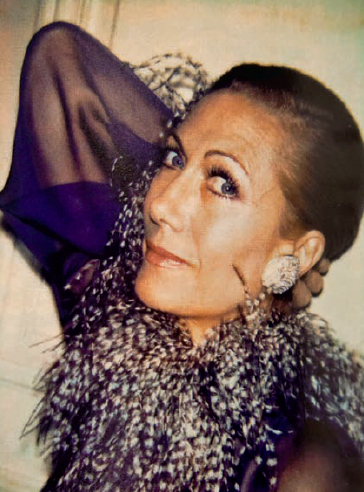Hélène Rochas
Andy Warhol
1974
Acrylic and silk - screen print on canvas
101,6 x 101,6 cm
Acquisition year 2007
Inv. 0210
Catalogue N. A199
Provenance
Exhibitions
Bibliography
In an evening dress designed by Madame Grès, Hélène Rochas stands out for her charismatic gaze: she has become an ageless figure.
Andy Warhol’s interest in the imagery of consumerism, his mimicry of the language of advertising and his adoption of a seemingly cold, massproduced and anonymous style are what made him the most emblematic figure of Pop Art. Nevertheless, it would be an oversimplification to associate him solely with that phenomenon: through research that matured in the early 1960s and continued all the way through to the mid-1980s, he represented much more, so much so that he became a key figure representing the 20th century as a whole. First and foremost, he embodied the iconography of the contemporary artist: no longer a genius and a misfit – like Jackson Pollock and the Abstract Expressionist generation – but a successful man, a talented manager of both himself and his Factory, able to set fashions in terms of customs and music. This was also made possible because he became a global success almost overnight. He was just as well-known as Hollywood stars and the international jet set, whose faces invaded his paintings almost obsessively. As Pat Hackett recalled in The Andy Warhol Diaries:
“For most of the seventies and continuing right up until Andy’s death, finding people to commission him to do portraits was a major activity, since it brought in a big share of his annual income. No matter what other canvases he was working on for museum and gallery shows, there were always portraits in the works in some corner of the loft.”1
The picture of Hélène Rochas is one of the so-called “Vanity Portraits”, painted on commission and produced consistently from the early 1970s, when the artist returned to painting after several years of experimenting with film. He usually created various versions, each one different from the next. The first one for the client usually sold for $25,000, while the others sold on the market for $5,000. In the case in question, the sitter asked the artist to create four works for her, and so he made a total of twelve overall.2 Like all the images from that period, this portrait also derives from a long session with a Polaroid. After choosing the shot he wanted, Warhol got his assistants to create a silk-screen print of it on a canvas already painted with generous brushstrokes laden with acrylic. At the level of the showy feather scarf, note the presence of the double blue and brown print that generates a continuous effect of optical vibration.
Standing out for its dominant green colour, the Cerruti work – number 2694 in the artist’s catalogue raisonné3 – came from The Andy Warhol Foundation for the Visual Arts in New York, where it was inventoried as PO 50.460 in its archives. On 3 April 2007, Cerruti purchased it for €470,863 at the Artcurial auction at the Hôtel Dassault in Paris, and it has formed part of his collection ever since.
Born in 1927 in Montauban-de-Picardie, with a past as a model and an actress, Nelly Brignole adopted the name she is known by today after meeting Marcel Rochas, designer and founder of the eponymous fashion house, when she was sixteen years old. She was widowed in 1955 and took over the reins of the company that had since become a household name in the perfume sector too. It was then that Hélène Rochas revealed her abilities as a naturally stylish, yet savvy businesswoman of a natural elegance at the helm of a cosmopolitan fashion house. She lived in an elegant Parisian apartment in a hôtel particulier in the 7e arrondissement, on Rue Barbet de Jouy, where she built up an extensive art collection. Consisting primarily of Art Deco pieces, it was sold off at a Christie’s auction in September 2012, just a year after her death. It was then that two of her portraits by Warhol were also sold, differing from the one in the Cerruti Collection because of their dominant blue and pale green colouring.
The Polaroid of Madame Rochas next to the fireplace in her apartment dates back to 1 December 1973, when Warhol paid a work visit to Europe (fig. 1). After returning to New York, the artist produced the works on canvas at the start of the new year so that he could include some copies in his solo show scheduled for February at the Sonnabend Gallery in Paris. Visitors to this exhibition were able to admire Warhol’s latest works: in addition to the Rochas portrait, there were also portraits of Attilio Codognato, David Hockney, Henry Geldzahler and Alexander Jolas. A comparison with the original photograph enables us to understand the artist’s technique. Warhol rotated the image by ninety degrees to obtain a more captivating pose. The passage from the photo to the silk-screen print did away with all the chiaroscuro effects, while the relationship between the figure and the background loses its definition to play with the ambiguous permeation between the different levels. In an evening dress designed by Madame Grès, Hélène Rochas stands out for her charismatic gaze: she has become an ageless figure.
Fabio Belloni
1 Hackett 1989, p. XIV.
2 King-Nero, Printz 2010.
3 Ibid.
Fig. 1. A. Warhol, Hélène Rochas, 1973, photograph.

